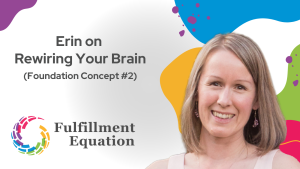
Now that we have a clear picture for our future fulfillment, we can start the journey of connecting that wild, beautiful, long-term vision to our present life. But how do we do that? What if the distance between where I am and that future state feels less like a direct, well-marked path and more like trying to leap over a giant chasm on a motorcycle, blindfolded!
The goal of this next step is to create a personal strategy – a model – that will give us clarity and focus. It will be like taking off the blindfold so that we can see clearly, and constructing a bridge over the gap so that we can safely and efficiently navigate to the other side. Waiting there with anticipation, ready to greet you, will be your desired future self.

Instead, construct a clearer, faster and more direct route to your future fulfillment.
This step is arguably the most difficult and, because our brains work differently from one another, there is no single approach that works for everyone. Luckily, there are a few different paths we can take to get to the same goal of creating our personal strategy. You can simply choose the approach that works best for you, and if you try one path and find you’re not getting anywhere, you can easily change courses and try a different approach.
Before we get into building the strategy, let’s set the stage with two things. Firstly, we need to assess where we’re at with our vision. This is an important exercise to do that will give us insightful information, regardless of the approach we decide to take. After that, I’m going to tell you a story that we can lean on as an example throughout this step. It will help to describe the different approaches you can take in building your personal strategy.
Your Benchmark Vision Assessment
So, where do we stand currently, relative to our vision of the life of our future self? In some areas, we may feel impossibly far away, while in others maybe we’re a little closer. Let’s do an assessment exercise that we can use as a benchmark for our progress going forward. Having done this initial rating will be important to us later when we do similar assessments in the future. It will also give us some insight into the areas that need the most attention. We can use these insights right away when building our strategy.
To do the assessment, first write down your 7-10 vision sentences (from Step 1) vertically on a piece of paper. Then create a column next to them that you will use for your rating. Your rating will be a number from 1 to 10 for each of the sentences. This was why it was important in constructing the sentences to have each of them only contain one dream.
Start with the first sentence – read it aloud and picture it in your mind. How true is that sentence for you currently? Give it a rating between 1-10, where 1 is “I couldn’t possibly be any further away from that than I am right now” and 10 is “That is 100% true for me / Done and done!” Chances are, you’ll likely be somewhere in the middle of those two extremes. Continue to move through each sentence, one at a time – visualizing it, feeling how much of it is true for you now, and then applying a rating. If you have trouble applying a rating, go back to the article on Step 1 and review the “Testing for Usefulness” section to ensure your vision sentences are written in a way that makes it possible to effectively rate your progress. At the end of the exercise, you will have one rating for each sentence.
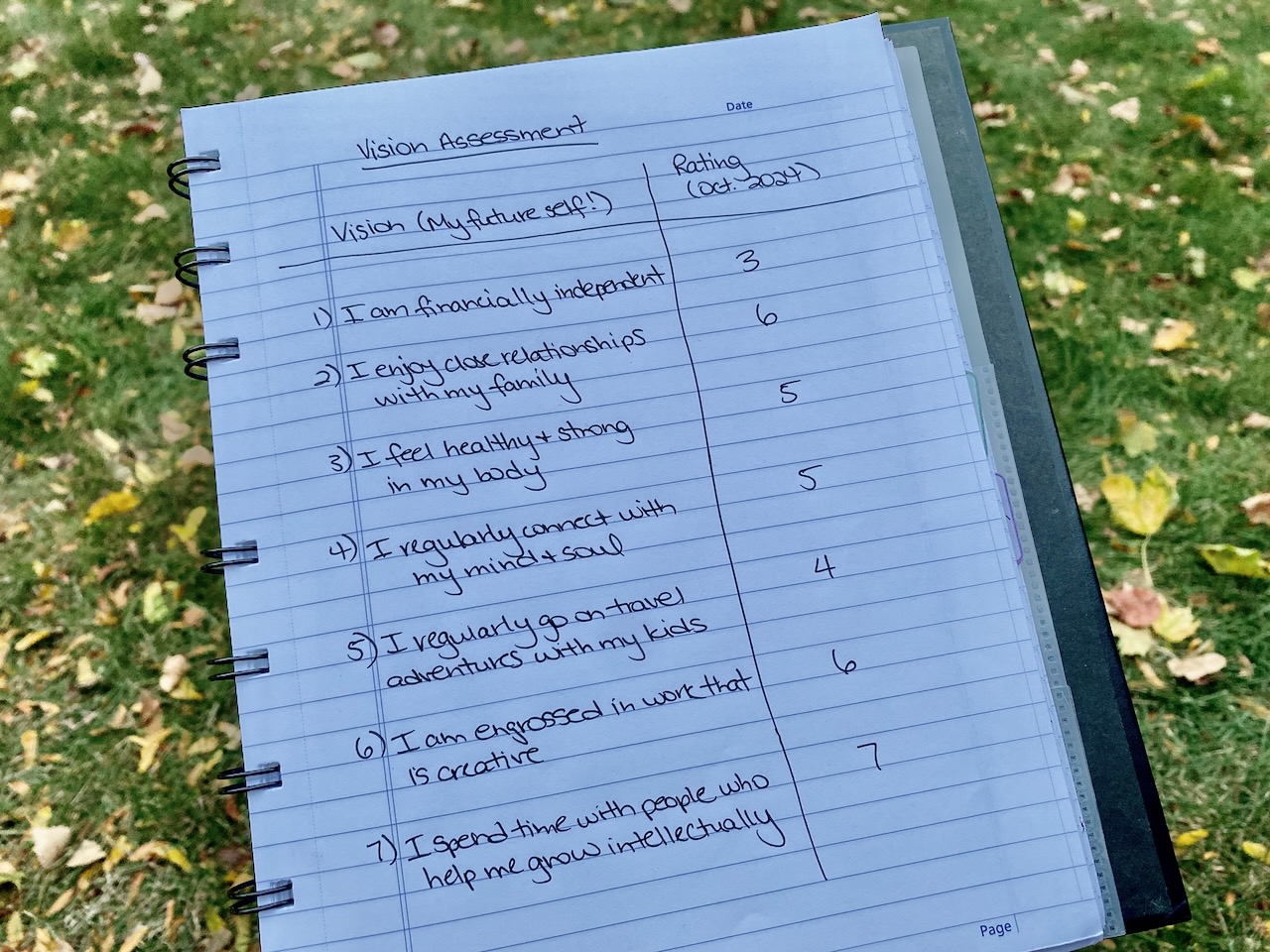
Your Personal Strategy Model
Set your assessment aside for now. We’ll be using it in a moment as we build our personal strategy model. First a story…
We have a space in our basement that is a play area. It’s where the toys live! When you reach the bottom of the basement stairs, there is a finished area that is the shape of a small square. Around the edge of the space are four rectangular tables. Most of the kids’ toys at this point are Playmobil. If you’re not familiar with these, they are plastic figures for imaginative play. After many birthdays and Christmases over the years, we have amassed a good collection of Playmobil and all three of the kids have loved the stuff.
The Playmobil is normally stored and played with on top of the tables, however right now, as I’m writing this, the space is a complete mess. The table tops are remarkably clear and the mass of toys is carpeting the floor. Whether you’re a parent or not, I’m sure you can relate! There isn’t a single spot left to sit, so the kids aren’t happy with things in this state either.
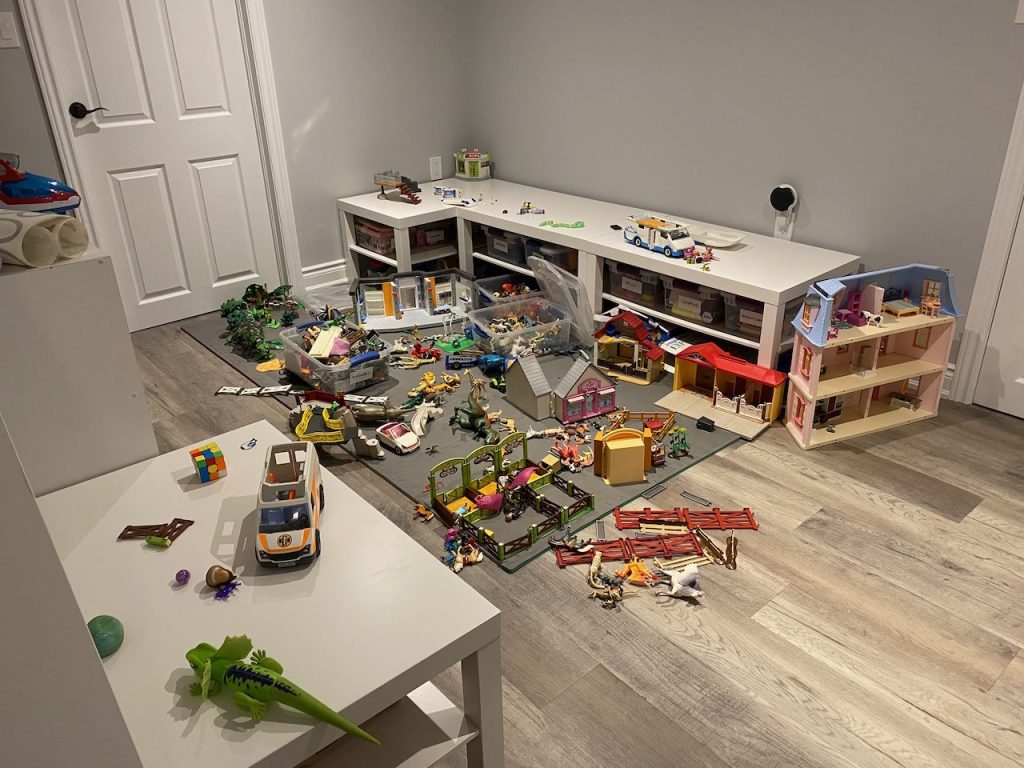
Here’s where I’m going with this… Even when it comes to something as common as toys all over the floor, there is a vision and a desire to move toward that future state. There is also likely confusion and frustration about how to get there. In this case, the vision is to have a floor that is clear to walk or sit on and the toys stored in a way that they can be easily played with. I’m going to use this simple analogy of the toys to help demonstrate three different approaches we can take to designing our personal strategy model.
Regardless of the approach, the structure of the model will be the same. At the very top is our vision, underneath that are our big pursuits (I like to call them the “pillars”) and at the bottom are the more specific pursuits (I call these the “priorities”). The pillars are essentially our areas of focus and the priorities represent the things that are the most important parts of each pillar. Our task now is to populate this shell of a model with the content that is unique to you so that you can use the model to cross that chasm and start living your future fulfillment.
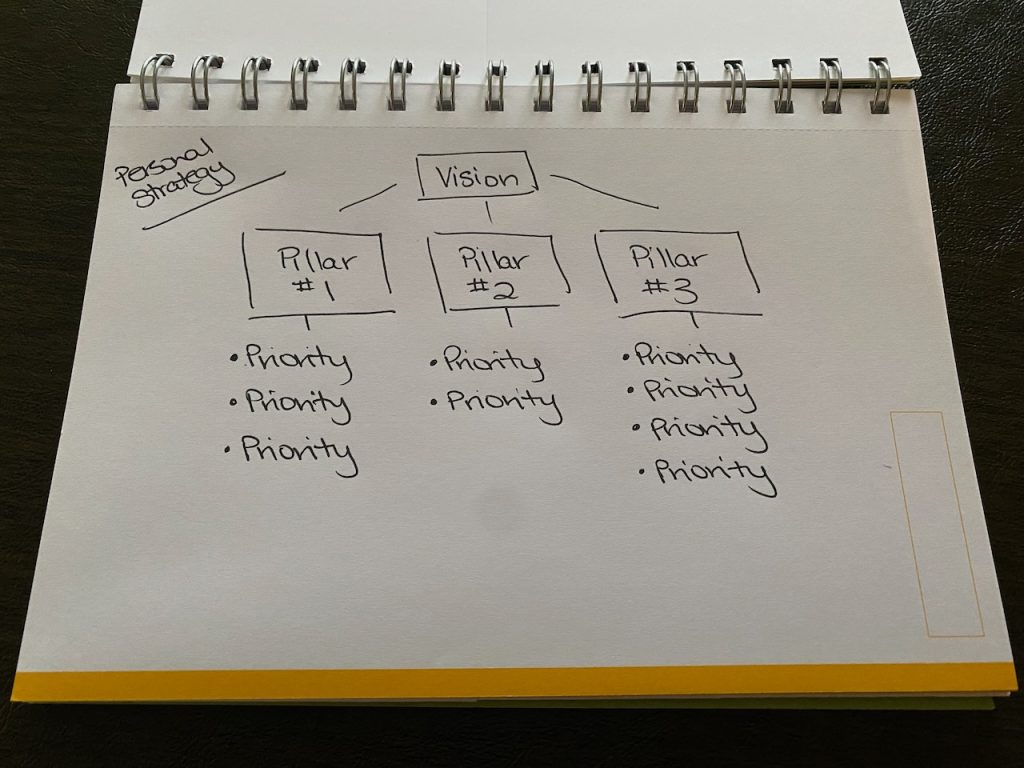
How To Use This Guide
Based on the descriptions of which one may be best for you, select one of these three approaches to guide you through identifying your pillars and priorities. If you try one approach and find yourself getting stuck, don’t worry! Simply take a stab at it using another approach. Sometimes a combination of approaches is best for tackling this exercise. Also remember that you may not fill in the full model in one sitting. Working on it for a bit and then letting your brain run with it in the background for a day or two can be helpful. It often allows you to have some fresh perspective and insights when you come back to it.
Approach #1: Designing From the Top-Down
This approach may be best for you if…
- You feel comfortable with, and possibly have experience with, high-level strategic thinking.
- You prefer to come up with the ideas and leave the details to someone else.
- You can spot patterns and themes in abstract concepts.
This approach is also the best starting point if you’re not sure about the above bullets and just want a place to begin!
What this looks like in our toy story…
This is likely the most common approach to working towards our vision of a clean and tidy playroom. We’re going to start by identifying themes around the biggest pieces (the house, the hospital, the barn, the zoo structure) and then put those in place first. Then we’ll work to find the medium-sized pieces and align them with the large structures – e.g. furniture for the house, equipment for the hospital, fences for the farm and big animals for the zoo. Then, finally, we’ll fill in the gaps with the tiny pieces as they relate to each of the main structures.
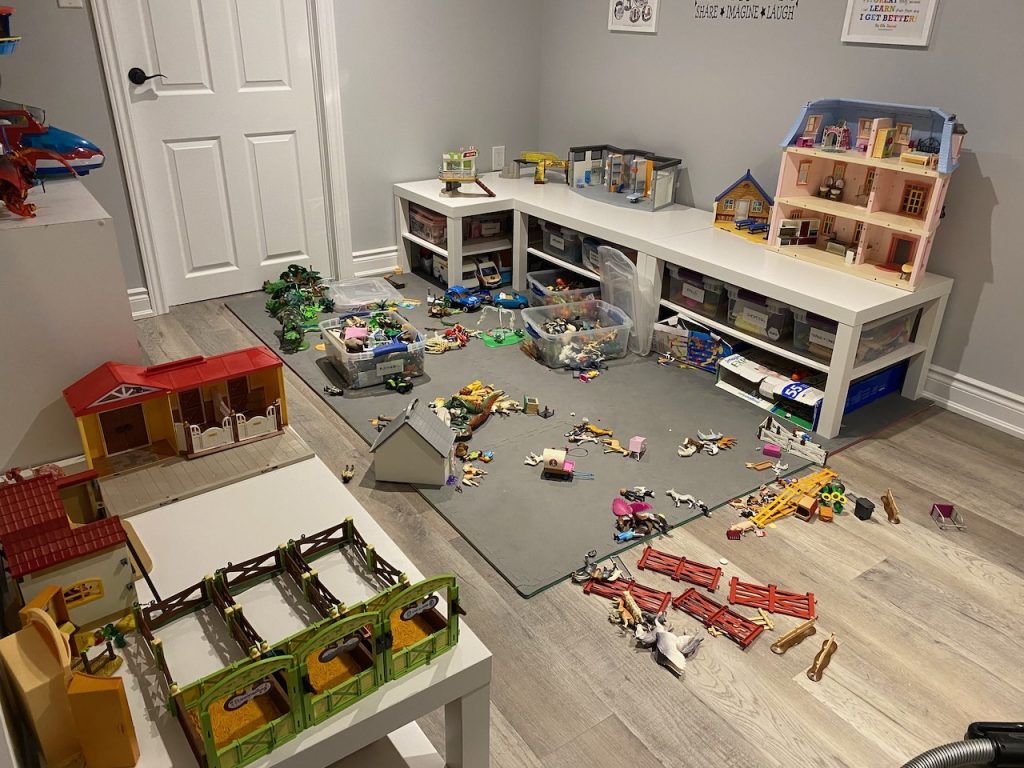
How to use this approach for your personal strategy model…
First, we’ll want to identify our pillars. These pillars are high-level representations of what we want to be most focused on. We’re looking to summarize each pillar in one or two words.
Start with your vision and your initial assessment. Can you spot some common themes in your vision statements? What are the outcomes that you’re trying to drive?
For example, if three out of eight of your vision statements say things like “I feel strong in my body” and “I eat healthy food at every meal” and “I regularly connect with my mind and soul”, then perhaps there’s a common theme there that we could call “Health” or “Well-being”.
Sometimes there could be a couple of different angles you can take when it comes to theming. If you have a vision sentence like “I regularly go on travel and exploration adventures with my kids” then you could pair it with another vision sentence like “I have lots of time with my kids to connect with them and support their development” to have a theme around “Family”. Alternatively, you could pair it with a vision sentence like “I live in places that interest and inspire me” to come up with a theme of “Travel”.
Another way to identify your pillars, this time without finding common themes amongst vision statements, is to take a look at your initial assessment and focus on the parts of your vision that you feel furthest from. Perhaps you rated many of your vision sentences between 5-7 out of 10, but one sentence was 2 out of 10. That part of your vision may not have a relationship with any of your other vision statements, but you can still build a pillar out of it. Simply give it a label. So, for example, if you are feeling really far from a vision sentence like “I am financially independent”, then perhaps “Financial Independence” is a pillar for you.
Ultimately, you’ll want to land on 2-4 pillars. If you have more than that, you may not have grouped them at a high enough level or you may need to be more selective. Ask yourself, is there a common theme between any of these? Maybe you have “Family” and “Friends”, and you could combine them into “Relationships”. Or ask yourself, are some of these more important than others? You may have found a theme, but it doesn’t rise to the level of the other themes you’ve identified. Let go of the little ones, or see if they have a relationship with one of the heftier themes.
Once you’ve finalized your pillars, it’s time to identify your priorities. Priorities are the key pieces of your pillar. Again, you’ll want to aim for no more than 2-4 priorities per pillar with no more than 10 priorities total across all pillars. Any more than this and we’ll lose the value of focus. As they say, when everything is important, nothing is important.
If you’ve combined themes to create a pillar, identifying priorities is likely easy. For example, “Family” and “Friends” can now be two priorities within the “Relationships” pillar.
Otherwise, ask yourself, what are the key elements of this pillar that are most important to me? If I was to break the pillar into pieces, how would I describe those parts? Take something like “Financial Independence”. How do we get there? One approach might be to consider that our net worth is the sum of our assets minus our liabilities. So maybe there are priorities related to assets such as “Income” or “Investments” and priorities related to liabilities such as “Expenses” or “Budget”.
Similar to pillars, which are captured in 1 or two word labels, priorities should be phrased in as few words as possible. However, unlike pillars, the language of our priorities should start with a verb. Continuing the example above, the priorities for the pillar “Financial Independence” might be written as “Increase Income” or “Grow Investments” or “Reduce Expenses” or “Meet Budget”. The reason we include a verb for priorities is that we want to capture the action that’s taking place or the description of the change. This helps give us more guidance and direction when we put our strategy into practice!
If this approach worked for you, skip to the Quick Double Check section further along, or you may also find it interesting to try one of the other approaches and see if you come up with the same content. If high-level theming was difficult, try the next approach.
Approach #2: Designing From the Bottom-Up
This approach may be best for you if…
- You haven’t had a lot of experience in strategic thinking.
- You prefer to focus on the details.
- You can spot patterns and themes in large amounts of concrete things.
- You find yourself overwhelmed with Approach #1.
What this looks like in our toy story…
Looking at the mass of toys, it’s fairly easy to pick out the largest pieces and label them. But pretend that the size wasn’t as obvious. Where would you begin when it comes to theming? Another approach we could take with the clean up is to have a closer look at the pieces and see if we can find patterns in them. We scan the floor to find the following: table, chairs, couch, plates, cutlery, ambulance, hospital beds, medicine bag, hay, horses, pitchfork, tractor, tigers, giraffes, elephants, monkeys.
Okay, maybe we didn’t see them in that exact order, but it wouldn’t take long before you would start to see some commonalities. You could then group like things into a pile and after a while you might notice that you have four large piles. You could then give each pile a label – home, hospital, farm, zoo – and set them up on the tables accordingly.
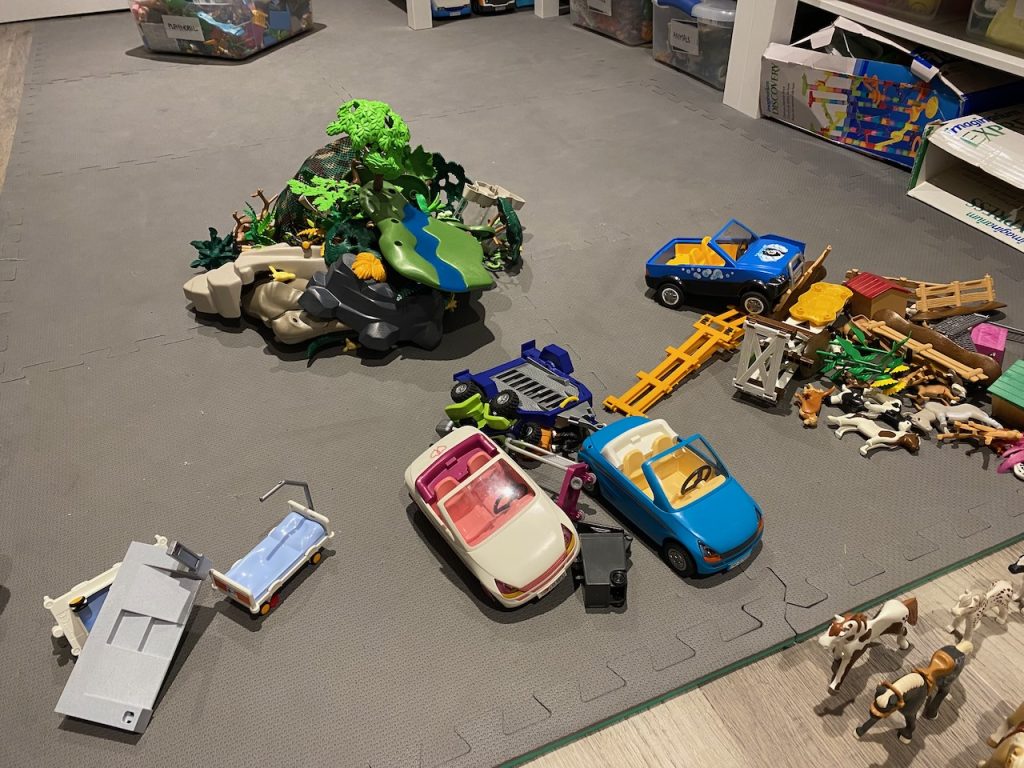
How to use this approach for your personal strategy model…
In this approach we’re still aiming to identify our pillars and priorities, but we’re going to come at it from a different angle. To start, make a list of the things that are important to you to be spending time on. These are things you could be working on or things you love doing. If you’ve already built your unique equation, then you’ll have done a lot of this thinking already. In fact, these are likely the components of your equation! It’s also possible to include things that you want to do, but haven’t yet started.
As an example, if I was to make a list, it would look something like this:
- I like to travel
- I am working on simplifying our home
- It’s important to me that I closely manage our budget
- I like to scrapbook
- I want to make videos of our travels
- I enjoy working on Fulfillment Equation
- I like spending time with my family
These elements are very close to the components of my equation, with one main difference. Things I put in this list are things I want to make CHANGE on. In the business world, we differentiate between things that are strategic and things that are operational. The strategic activities are change pieces and the operational activities are routine, day-to-day work. Both are important. However, when it comes to your personal strategy, you just want the strategic pieces.
For example, a common component of my unique equation is Exercise. Yet, I didn’t write a bullet about exercise above. Why? Because I’ve operationalized it. I have a certain rhythm around exercise that I’m happy with and I’m not focused on changing that at this time. Now, if I were to decide that I wanted to run a marathon, that would represent a change! In that case, I would want to include something to represent the effort and energy I would need to put into realizing that dream.
Once you have your list, ask yourself: what’s the motivation behind each of the items? Literally, look at each line one at a time and ask “why?”. This will give you a clue on how to group them and what your pillars might be. This “why” is really important. For example, without it you might look at my list above and notice that the lines “I like to travel” and “I want to make videos of our travels” both have the word travel in them, and so maybe that’s a theme. Possibly, but when I dig for the higher power behind each of those lines, I get something different. For me, the scrapbooking, the videos, the Fulfillment Equation work and my family are all part of my purpose. The why for me behind “simplifying our home” is so we can travel more easily. And the why behind travel is because I want to live a certain lifestyle – one with more time and location independence. So interestingly, the bullets around travel and simplifying our home are actually very closely related!
Using this kind of thinking, see if you can identify 2-4 pillars. These pillars are the themes that emerge as you group things together based on your “why” questioning. Write these pillars down using only 1-2 words each. In my example above, I would come up with 3 pillars: “Purpose”, “Lifestyle” and “Financial Independence” (which is the pillar that emerges from the why behind my line about budgeting).
Now rewrite the items from your list as priorities under the relevant pillar. As mentioned in Approach #1, priorities should be phrased in as few words as possible, starting with a verb. So in this example, I would transform the language of my lines above into priority language as follows:
- “It’s important to me that I closely manage our budget” → “Manage Expenses”
- “I want to make videos of our travels” → “Complete Travel Videos”
- “I am working on simplifying our home” → “Simplify Home”
- “I enjoy working on Fulfillment Equation” → “Create Fulfillment Equation”
One of the flaws of this approach is that sometimes when we go from the detailed to the high-level, we can miss the forest for the trees, so to speak. It’s best at this point to go back and try Approach #1 again now that you have a draft. The reason is because it will help you round out your perspective and ensure you haven’t overlooked things that are important to your future, but don’t yet have a presence in the now. For example, I had only captured the expense side of “Financial Independence” in my list. Knowing now that financial freedom is a pillar, I can ask myself what other priorities I could include in that area of focus in order to round it out. Continuing with the example, I’ll add “Grow Investments” as a priority under the “Financial Independence” pillar and that will be a good prompt for me, as we put our strategy into practice, to set aside some time in this area. Check to make sure you don’t have more than 10 priorities across all pillars.
As mentioned, if this approach worked for you, I would recommend refining your pillars and priorities by revisiting Approach #1. Following that, you can skip to the Quick Double Check section further along. If Approach #2 was difficult as well, try the next approach.
Approach #3: Helping Hand
This approach may be best for you if…
- You haven’t had a lot of experience in strategic thinking.
- You don’t enjoy getting into the details.
- You find yourself overwhelmed with approaches #1 and #2.
- You want a fast-track through this step.
What this looks like in our toy story…
In this scenario I bring in a set of bins, each of which has a label: Police Station, House, Playground, Hospital, Mall, Circus, Farm, Zoo, Pirate Ship. Then we all work together to sort the pieces into the most relevant categories. Once all the pieces have been assessed, we should clearly see which of the bins are overflowing and which ones are not. In our case, we don’t have many toys related to the Police Station, Playground, Mall, Circus or Pirate themes. The other four bins, however, would be full. Now, we can set up the toys by organizing the contents of one bin per table, keeping the theming together.
How to use this approach for your personal strategy model…
Again, our goal here is to identify 2-4 pillars overall and 2-4 priorities for each pillar, with no more than a total of 10 priorities. If identifying pillars is too hard, try selecting from an adapted list of the fulfillment foundations:
- Financial independence
- Time independence
- Location independence
- Simplicity
- Adventure
- Creativity
- Purpose
- Relationships
- Nature
- Health
- Connection
Looking back at your vision, review each sentence one at a time and put a tally beside the category, or categories, above that best fit with the dream you’re describing. Feel free to add other categories if you find you need it.
Once done, review your results – which categories have the most tallies? These will become your pillars.
Now that your pillars are in place, use the prompts from Approach #1 to identify your priorities. Ask yourself, what are the key elements of this pillar? If I was to break the pillar into pieces, how would I describe those parts? You should be able to find clues in your corresponding vision sentences as to what you can capture as your priorities.
This approach can help you get started and then you can lean on the tactics from Approach #1 or #2 to refine your strategy and fill in any gaps.
Quick Double Check
Regardless of the approach or combination of approaches that you take, by the end of building your personal strategy, you should have the following:
- 2-4 pillars (1-2 word label each)
- 2-4 priorities per pillar (2-3 word label each where the first word is a verb)
- No more than 10 priorities overall
Draw out a fresh copy of your personal strategy. You’re now ready to put it into practice.
Looking Ahead
Congratulations! You now have a personal strategy mapped out. That is a solid step towards connecting your future fulfillment dreams to how you’re living in the present.
Now, how do we turn that strategy into action? In the next step, we’ll talk about how to build a consistent rhythm around reflection, goal-setting and behaviours. Most importantly, unlike other traditional, achievement-oriented approaches to strategy, we’ll focus on how to build this future-looking practice without sacrificing our fulfillment in the present. We will continue to repeat our mantra that the joy is in the journey, not the destination. And we’ll work to integrate our personal strategy practice with our unique equation practice so that our focus on building fulfillment in the present is actually enhancing our focus on building fulfillment in the future, and vice versa. When these two practices are dancing seamlessly together, rather than stepping on each other’s toes, it’s a magical and powerful thing!
Read Next Article: Step 3 – Putting Your Strategy Into Action


